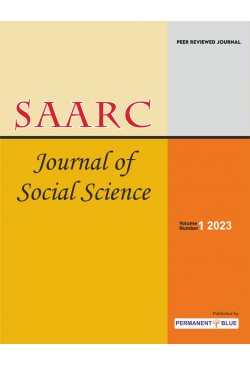
SAARC Journal of Social Science
Frequency :Bi-Annual
ISSN :2583-9950
Peer Reviewed Journal
Promoting Environmental Awareness among Secondary School Girl Students of Pune District: A Comprehensive Study on Education and Empowerment
This research study delves into the critical issue of promoting environmental awareness among secondary school girl students. In recent years, environmental concerns have gained prominence on the global stage, urging the need for comprehensive educational initiatives to empower the youth, particularly girls, with the knowledge and skills necessary to address environmental challenges. This paper explores the multifaceted aspects of environmental awareness within the context of secondary education for girls, aiming to shed light on the strategies and approaches that can effectively nurture a generation of environmentally conscious and responsible citizens.
The study begins by highlighting the significance of targeting secondary school girl students specifically. Research has shown that girls often face unique societal pressures and stereotypes that may deter them from pursuing environmental interests. However, when properly encouraged and educated, they can become powerful advocates for environmental causes.
The research identifies various components of environmental awareness, including knowledge acquisition, attitudinal changes, and behavioral shifts. It delves into the role of school curricula, extracurricular activities, and community involvement in shaping the environmental consciousness of secondary school girls. Moreover, it explores the impact of role models, peer interactions, and parental support in fostering a deep and lasting commitment to environmental sustainability.
Additionally, this study reviews existing educational programs and initiatives that have successfully promoted environmental awareness among secondary school girls. These programs often employ experiential learning, interactive workshops, and real-world engagement to create meaningful connections between young girls and the environment.
Furthermore, the paper emphasizes the importance of integrating environmental education into the broader framework of sustainable development goals. It argues that by educating secondary school girls about environmental issues, we are not only enhancing their awareness but also equipping them with the skills and perspectives necessary for tackling a wide range of global challenges.
In conclusion, this research underscores the urgency of fostering environmental awareness among secondary school girl students. It advocates for a holistic approach that combines formal education, community engagement, and mentorship to empower girls to become agents of change in the realm of environmental sustainability. By investing in the environmental education of young girls, we can pave the way for a more sustainable future, where informed and passionate individuals actively contribute to preserving our planet.
P. Viswanadha Gupta (2023). Promoting Environmental Awareness among Secondary School Girl Students of Pune District: A Comprehensive Study on Education and Empowerment. SAARC Journal of Social Science, 1: 1, pp. 1-14.
Gendered Migration; Post Liberalization Trends in Indian Mega Cities
Parmeet Kaur & Abhimanyu Singh (2023). Gendered Migration; Post Liberalization Trends in Indian Mega Cities. SAARC Journal of Social Science, 1: 1, pp. 15-30.
Urbanisation and Slum Growth in Assam
Pranjit Nath & Jhimli Bhattacharjee (2023). Urbanisation and Slum Growth in Assam. SAARC Journal of Social Science, 1: 1, pp. 31-46.
Kolkata’s Kinetic Kinnars: A Pilot Study on the Various Communicative Aspects of the Endangered Farsi Hijra Language
‘Kinnar’ is the umbrella term ascribed to the third gender or the hijras, as they are known in Bengal. The Kinnars have been a part of the society since ages. In spite of using the local regional language, the Hijras have a secret language that they use to communicate among themselves. The paper deals with a secret language used by the Hijras for generations, known as Farsi Hijra. The Hijras believe that they, being a community, should have their own culture and language and they are never ashamed of using the language, rather they feel proud about it. The Hijras believe that this is one of the oldest languages. But this language lacks a script, it is learned verbally and is passed on from one generation to the other. The paper contains mainly first-hand primary data collected from ten (10) transgender respondents residing in Kolkata, a city in West Bengal in India. Since this secret language has no script, therefore it has no written grammar rules. The language is changing everyday from person to person and region to region and the pronunciation also varies from place to place. The Hijras of Kolkata being more in contact with Bengali language, they use the language in a Bengali accent. From the primary analysis of the obtained data, we find that this language is a Subject-Object-Verb (S-O-V) language, just like Bengali. The person marker and case markers have also been identified in the language. Just like any other language this language too has three tenses. We have also envisaged to study the cultural aspects of Farsi Hijra language including their number system, the way they address their family members and the rituals they follow when one dies. Another interesting factor has been reported here is the usage of the word mashi (aunt) as an ending in many words. From the audio recordings collected, a preliminary fundamental frequency (F0) analysis has been done to compare the pitch variations of transgender population from male and female populations. The results and implications have been discussed in detail
Keywords: endangered language, case marker, s-o-v language, hijra, gender-based language, verbal language, no script, positive attitude, community.
Sayantika Das and Shankha Sanyal (2023). Kolkata’s Kinetic Kinnars: A Pilot Study on the Various Communicative Aspects of the Endangered Farsi Hijra Language. SAARC Journal of Social Science, 1: 1, pp. 47-61.
Banditry and Human Security: Implications on Mental Health
Femi Rufus Tinuola, Helen Anthony Ekpe & Blessing Ose Oligbi (2023). Banditry and Human Security: Implications on Mental Health. SAARC Journal of Social Science, 1: 1, pp. 63-74.
Women Domestic Workers in Neo-liberal Era: A Study on Low Wage Employment
Meera Swain & Rajadarshini Patra (2023). Women Domestic Workers in Neo-liberal Era: A Study on Low Wage Employment. SAARC Journal of Social Science, 1: 1, pp. 75-92.